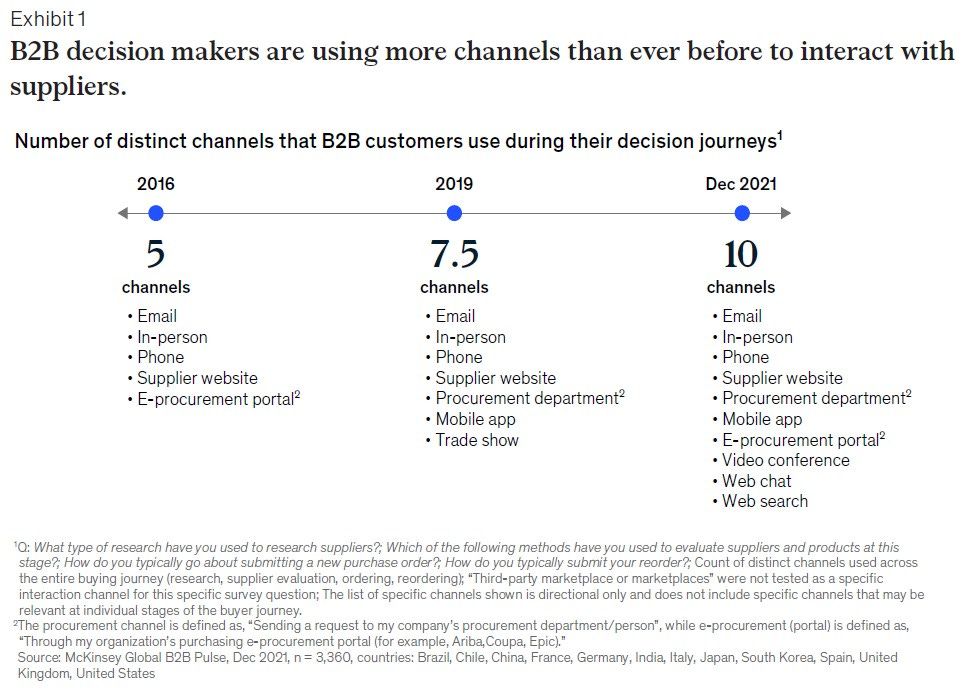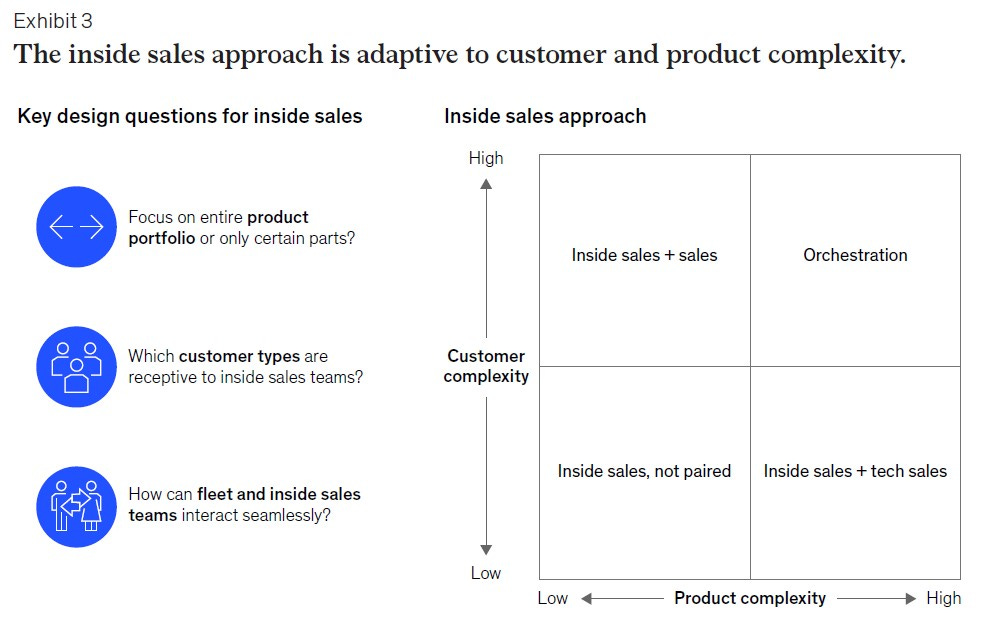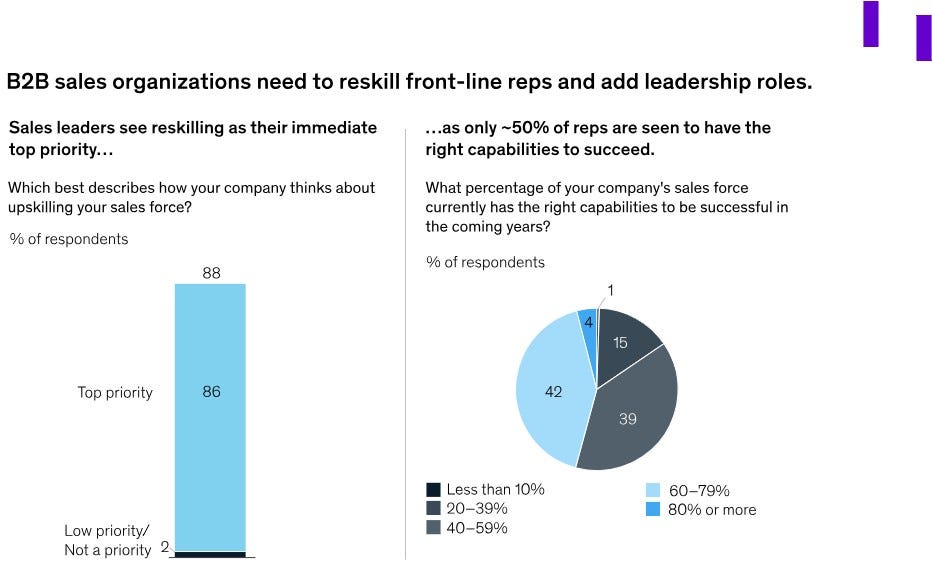B2B Sales: navigating the Winds of Change
Insights from McKinsey's studies
I recently came across a couple of insightful documents from McKinsey on B2B sales and wanted to share some key highlights. Whether you're a sales rep or a manager, there’s something in these findings for everyone.

Customer engagement: the shift toward active buyers
As always, successful sales start with the customer. McKinsey's studies emphasize an undeniable shift: buyers are becoming increasingly proactive in seeking out information and educating themselves about the solutions they need. This shift marks the end of the old model of information asymmetry that once made selling easier.
So, how do Vendors respond? The answer is omnichannel.
Since Customers now engage with Vendors across multiple touchpoints, it’s essential for sales teams (as a whole organization) to adapt. The various channels of information—whether digital, phone, or face-to-face—must be synchronized, complementary, and action-oriented to provide a seamless customer experience.
Inside and Hybrid Sales: the new breed of selling
As part of this omnichannel strategy, McKinsey notes the growing popularity of a new breed of sales models:
Inside Sales: A remote, customer-facing role where salespeople manage the entire sales cycle. These roles are becoming increasingly important as businesses embrace digital transformation and prioritize efficiency.
Hybrid Sales: A flexible model combining the efficiency of inside sales with the personal touch of traditional in-person interactions. This approach allows sales teams to engage with customers both remotely and face-to-face, depending on the situation.
A diagram from McKinsey does a great job illustrating when and where each of these models is most appropriate, helping businesses understand which approach will work best for specific customer needs.
More insights here:
BtoB Sales: What Can We Learn from Dentists?
Selling vs. Non-Selling activities: where do we draw the line?
The role of technology: AI and automation in Sales
One of the key takeaways from these studies is the growing importance of AI and automation in supporting the sales process. These tools are already helping sales teams optimize lead generation, automate repetitive tasks, and boost overall productivity.
For inside sales reps, these technologies are particularly beneficial. They help streamline processes and enhance efficiency, allowing salespeople to focus on building relationships and closing deals. Outside sales teams, too, stand to benefit—though they often face additional challenges, such as being tasked with non-sales activities, which can hinder their productivity.
As I see it, specialization is key. Sales tools are not just about keeping up—they're about staying ahead and maximizing your team’s effectiveness, particularly when it comes to inside sales.
Embracing change: the "Tsunami" of Digital Transformation
At this point, a picture comes to mind: I recall a cartoon I saw once—a Kodak camera suntanning on the beach while a massive tsunami wave labeled "Digital" approaches. While I can’t find the exact image, the metaphor is clear.
There’s a tidal wave of change headed your way, whether you’re a sales rep or a manager. The key is to embrace it. Change is inevitable, and those who are adaptable—who are willing to step out of their comfort zones and learn new ways of doing things—will come out on top. Think of it like an artist adding new tools to their palette. The more you adapt, the more colors you have to work with.
More insights here:
BtoB Sales: keep your product up to date and remarkable
Career path: the rise of Inside Sales
Another positive development highlighted in McKinsey’s research is the emergence of a clearer career path within sales. Not long ago, becoming a sales rep was often seen as a starting point, with little room for specialization or upward mobility. But now, inside sales is becoming its own distinct role, offering professionals a more defined path to advancement.
Inside sales roles provide an excellent entry point for those just starting in sales. And, for those who wish to eventually transition, there’s a natural progression to more traditional outside sales roles, though this is more of an evolution than a strict opposition.
The need for tools adoption: a mindset shift
The willingness to adapt is just as much about mindset as it is about the tools themselves. However, for more senior team members, the challenge may be even greater. Having worked in several organizations, I’ve seen firsthand how newcomers don’t face the same resistance when changes are made to processes or systems. This is because they don't have the legacy systems to unlearn.
For senior reps, the adjustment can be tougher. Yet, exceptional performance can buy you some leeway. If you’re consistently smashing your quota, you may get away with not using the latest tools. But, when performance begins to slip, not adopting these tools could become a disadvantage. You may start to be seen as the "dinosaur" who refuses to adapt, and we all know how that story ends.
More insights here: :
B2B Sales Management: Are you in $ales? Please c’mon in. Make yourself uncomfortable.
The skills gap: opportunity for growth
Another significant insight from McKinsey's studies is the finding that organizations believe only 50% of their sales teams have the right skills to succeed. While this might sound like a problem, I actually see it as a positive. It’s an opportunity.
There’s room for growth, both for individuals and for the organization as a whole. Whether you invest in your own training or ask your organization to provide it, this gap in skills presents a chance to level up.
This need for skill development spans not only across individual sales reps but also through cross-functional teams and different levels of management.
Conclusion: take initiative and stay ahead
In conclusion, be aware of the “winds of change” sweeping through the B2B sales landscape. Take the initiative to make your product—that is, yourself—remarkable. Be proactive in seeking opportunities for growth, whether that’s by embracing new technologies, developing new skills, or taking on a more specialized role.
The opportunities are out there. Embrace them, and the future of B2B sales can be yours.
Sources:
McKinsey & Company, The Multiplier Effect: How B2B Winners Grow
McKinsey & Company, Building Next-Generation B2B Sales Capabilities





